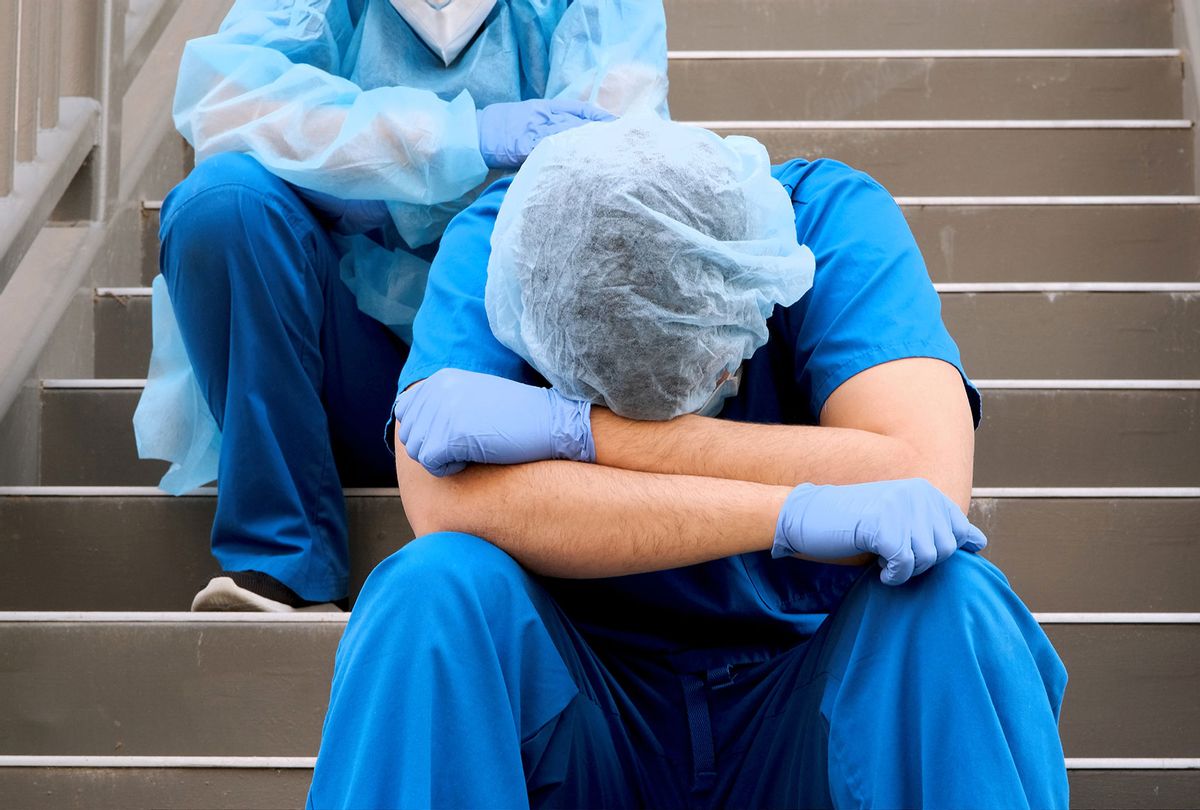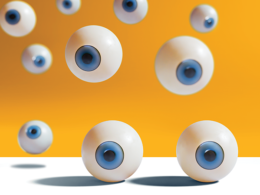About one in five health-care workers has left their job since the pandemic started. This is their story — and the story of those left behind.
The Atlantic
By Ed Yong
NOVEMBER 16, 2021
The moment that broke Cassie Alexander came nine months into the pandemic. As an intensive-care-unit nurse of 14 years, Alexander had seen plenty of “ Hellraiser stuff,” she told me. But when COVID-19 hit her Bay Area hospital, she witnessed “death on a scale I had never seen before.”
Last December, at the height of the winter surge, she cared for a patient who had caught the coronavirus after being pressured into a Thanksgiving dinner. Their lungs were so ruined that only a hand-pumped ventilation bag could supply enough oxygen. Alexander squeezed the bag every two seconds for 40 minutes straight to give the family time to say goodbye. Her hands cramped and blistered as the family screamed and prayed. When one of them said that a miracle might happen, Alexander found herself thinking, I am the miracle. I’m the only person keeping your loved one alive. (Cassie Alexander is a pseudonym that she has used when writing a book about these experiences. I agreed to use that pseudonym here.)
The senselessness of the death, and her guilt over her own resentment, messed her up. Weeks later, when the same family called to ask if the staff had really done everything they could, “it was like being punched in the gut,” she told me. She had given everything-to that patient, and to the stream of others who had died in the same room. She felt like a stranger to herself, a commodity to her hospital, and an outsider to her own relatives, who downplayed the pandemic despite everything she told them. In April, she texted her friends: “Nothing like feeling strongly suicidal at a job where you’re supposed to be keeping people alive.” Shortly after, she was diagnosed with post-traumatic stress disorder, and she left her job.
Since COVID-19 first pummeled the U.S., Americans have been told to flatten the curve lest hospitals be overwhelmed. But hospitals have been overwhelmed.
The nation has avoided the most apocalyptic scenarios, such as ventilators running out by the thousands, but it’s still sleepwalked into repeated surges that have overrun the capacity of many hospitals, killed more than 762,000 people, and traumatized countless health-care workers.
“It’s like it takes a piece of you every time you walk in,” says Ashley Harlow, a Virginia-based nurse practitioner who left her ICU after watching her grandmother Nellie die there in December. She and others have gotten through the surges on adrenaline and camaraderie, only to realize, once the ICUs are empty, that so too are they.
Some health-care workers have lost their jobs during the pandemic, while others have been forced to leave because they’ve contracted long COVID and can no longer work.
But many choose to leave, including “people whom I thought would nurse patients until the day they died,” Amanda Bettencourt, the president-elect of the American Association of Critical-Care Nurses, told me.
The U.S. Bureau of Labor Statistics estimates that the health-care sector has lost nearly half a million workers since February 2020.
Morning Consult, a survey research company, says that 18 percent of health-care workers have quit since the pandemic began, while 12 percent have been laid off.
Stories about these departures have been trickling out, but they might portend a bigger exodus.
Morning Consult, in the same survey, found that 31 percent of the remaining health-care workers have considered leaving their employer, while the American Association of Critical-Care Nurses found that 66 percent of acute and critical-care nurses have thought about quitting nursing entirely. “We’ve never seen numbers like that before,” Bettencourt told me. Normally, she said, only 20 percent would even consider leaving their institution, let alone the entire profession. Esther Choo, an emergency physician at Oregon Health and Science University, told me that she now cringes when a colleague approaches her at the end of a shift, because she fears that they’ll quietly announce their resignation too. Vineet Arora, who is dean for medical education at University of Chicago Medicine, says that “in meetings with other health-care leaders, when we go around the room, everyone says, ‘We’re struggling to retain our workforce.’ Nobody says, ‘We’re fine.’”

When national COVID hospitalizations fell in September and October, it was possible to hope that the health-care system had already endured the worst of the pandemic. But that decline is now starting to plateau, and in 17 states hospitalizations are rising. And even if the country dodges another surge over the winter, the health-care system is hemorrhaging from the untreated wounds of the past two years. “In my experience, physicians are some of the most resilient people out there,” Sheetal Rao, a primary-care physician who left her job last October, told me. “When this group of people starts leaving en masse, something is very wrong.”
Health-care workers, under any circumstances, live in the thick of death, stress, and trauma. “You go in knowing those are the things you’ll see,” Cassandra Werry, an ICU nurse currently working in Idaho, told me. “Not everyone pulls through, but at the end of the day, the point is to get people better. You strive for those wins.”
COVID-19 has upset that balance, confronting even experienced people with the worst conditions they have ever faced and turning difficult jobs into unbearable ones.
In the spring of 2020, “I’d walk past an ice truck of dead bodies, and pictures on the wall of cleaning staff and nurses who’d died, into a room with more dead bodies,” Lindsay Fox, a former emergency-medicine doctor from Newark, New Jersey, told me. At the same time, Artec Durham, an ICU nurse from Flagstaff, Arizona, was watching his hospital fill with patients from the Navajo Nation. “Nearly every one of them died, and there was nothing we could do,” he said. “We ran out of body bags.”
Most drugs for COVID-19 are either useless, incrementally beneficial, or-as with the new, promising antivirals-mostly effective in the disease’s early stages.
And because people who are hospitalized with COVID-19 tend to be much sicker than average patients, they are also very hard to save- especially when hospitals overflow.
Many health-care workers imagined that such traumas were behind them once the vaccines arrived. But plateauing vaccination rates, premature lifts on masking, and the ascendant Delta variant undid those hopes.
This summer, many hospitals clogged up again. As patients waited to be admitted into ICUs, they filled emergency rooms, and then waiting rooms and hallways. That unrealized promise of “some sort of normalcy has made the feelings of exhaustion and frustration worse,” Bettencourt told me.
Health-care workers want to help their patients, and their inability to do so properly is hollowing them out. “Especially now, with Delta, not many people get better and go home,” Werry told me.
People have asked her if she would have gone to nursing school had she known the circumstances she would encounter, and for her, “it’s a resounding no,” she said. (Werry quit her job in an Arizona hospital last December and plans on leaving medicine once she pays off her student debts.)

COVID patients are also becoming harder to deal with. Most now are unvaccinated, and while some didn’t have a choice in the matter, those who did are often belligerent and vocal.
Even after they’re hospitalized, some resist basic medical procedures like proning or oxygenation, thinking themselves to be fighters, only to become delirious, anxious, and impulsive when their lungs struggle for oxygen.
Others have assaulted nurses, thrown trash around their rooms, and yelled for hydroxychloroquine or ivermectin, neither of which has any proven benefit for COVID-19.
Once, Americans clapped for health-care heroes; now “we’re at war with a virus and its hosts are at war with us,” Werry told me.
Beyond making workdays wretched, these experiences are inflicting deep psychological scars. “We want to be rooting for our patients,” Durham told me, “but anyone I know who’s working in COVID has zero compassion remaining, especially for people who chose not to get the vaccine.” T
hat’s why he has opted to do travel-nursing stints, which are time-limited and more lucrative than staff jobs: “It just isn’t worth it to do the job for less than the most I can get paid,” he said.
He’s still providing care, but he finds himself emotionally detached, and unsettled by his own numbness. For a health-care worker, being shaken by a patient’s death comes with the job. Finding yourself unmoved is almost worse.
Many have told me that they’re bone-weary, depressed, irritable, and (unusually for them) unable to hide any of that. Nurses excel at “feeling their feelings in a supply closet or bathroom, and then putting their game face back on and jumping into the ring,” Werry said.
But she and others are now constantly on the verge of tears, or prone to snapping at colleagues and patients.
Some call this burnout, but Gerard Brogan, the director of nursing practice at National Nurses United, dislikes the term because “it implies a lack of character,” he told me.
He prefers moral distress-the anguish of being unable to take the course of action that you know is right.
Health-care workers aren’t quitting because they can’t handle their jobs. They’re quitting because they can’t handle being unable to do their jobs.
Even before COVID-19, many of them struggled to bridge the gap between the noble ideals of their profession and the realities of its business.
The pandemic simply pushed them past the limits of that compromise.
The United States uses the rod of Asclepius-a snake entwined around a staff-as a symbol of medicine. But the pandemic suggests that the more fitting symbol might be the Ouroboros, a snake devouring its own tail.
Several health-care workers told me that, amid the most grueling working conditions of their careers, their hospitals cut salaries, reduced benefits, and canceled raises; forced staff to work more shifts with longer hours; offered trite wellness tips, such as keeping gratitude journals, while denying paid time off or reduced hours; failed to provide adequate personal protective equipment; and downplayed the severity of their experiences.
The American Hospital Association, which represents hospital administrators, turned down my interview request; instead, it sent me links to a letter that criticized anticompetitive pricing from travel-nursing agencies and to a report showing that staff shortages have cost hospitals $24 billion over the course of the pandemic.
But from the perspective of health-care workers, those financial problems look at least partly self-inflicted: Many workers left because they were poorly treated or compensated, forcing hospitals to hire travel nurses at greater cost.
Those nurses then stoke resentment among full-time staff who are paid substantially less but are often asked to care for the sickest patients. And in some farcical situations, “hospitals hired their own staff back as travel nurses and paid them higher rates,” Bettencourt said.
Whatever the intentions behind these decisions, they were the final straw for the many health-care workers who told me that they left medicine less because of COVID-19 itself and more because of how their institutions acted. “I’ve been a nurse 45 years and I’ve never seen this level of disaffection between clinicians and their employers,” Brogan told me. The same is true across almost every sector of the U.S. Record-breaking numbers of Americans left their jobs this April-and then again in July and August. This “Great Resignation,” as my colleague Derek Thompson wrote, “is really an expression of optimism that says, We can do better.”

The culture of medicine makes it hard for health-care workers to realize that. Most enter medicine “as a calling,” Vineet Arora told me, which can push them to sacrifice ever more of their time, energy, and self.
But that attitude, combined with taboos around complaining or seeking mental-health help, can make them vulnerable to exploitation, blurring the line between service and servitude.
Between 35 and 54 percent of American nurses and physicians were already feeling burned out before the pandemic. During it, many have taken stock of their difficult working conditions and inadequate pay and decided that, instead of being resigned, they will simply resign.
Molly Phelps, an emergency doctor of 18 years, considered herself a lifer. Her medical career had cost her time with her family, wrecked her circadian rhythms, and taxed her mental health, but it offered so much meaning that “I was willing to stay and be miserable,” she told me. But after the horrific winter surge, Phelps was shocked that her hospital’s administrators “never acknowledged what we went through,” while many of her patients “seemed to forget their humanity.” Medicine’s personal cost seemed greater than ever, but the fulfillment that had previously tempered it was missing. On July 21, during an uneventful evening spent scrolling through news of the Delta surge, Phelps had a sudden epiphany. “Oh my God, I think I’m done,” she realized. “And I think it’s okay to walk away and be happy.”
America’s medical exodus is especially tragic because of how little it might have taken to stop it. Phelps told me that if her workplace “had thrown a little more of a bone, that would have been enough to keep me miserable for 13 more years.” Some health systems are starting to offer retention bonuses, long-overdue raises, or hazard pay.
And the next generation of health-care workers doesn’t seem to be deterred. Applications to medical and nursing schools have risen during the pandemic. “That workforce is apparently seeing the best of us, and maybe their vision and energy is what we need to make us whole again,” Esther Choo told me.
But today’s students will take years to graduate, and the onus is on the current establishment to reshape an environment that won’t immediately break them, Choo said. “We need to say, ‘We got this wrong, and despite that, you’re willing to invest your lives in this career? What an incredible gift. We can’t look at that and change nothing.’”
The health-care workers who have stayed in their jobs now face a “crushing downward spiral,” Choo told me.
Each resignation saddles the remaining staff with more work, increasing the odds that they too might quit.
They don’t resent their former colleagues, but some feel that medicine’s social contract, wherein health-care workers show up for one another through tragedy, is fraying.
Before the pandemic, “I knew exactly who I would be working with in every single role,” Choo said. “There was a lot of unspoken communication, and my shifts were so smooth.”
But with so many people having left, the momentum that comes from trust and familiarity is gone.
Expertise is also hemorrhaging. Many older nurses and doctors have retired early-people who “know that one thing that happened 10 years ago that saved someone’s life in a clutch situation,” Cassie Alexander said. And because of their missing experience, “things are being missed,” Artec Durham added.
“The care feels frantic and sloppy even though we’re not overrun with COVID right now.”
Future patients may also suffer because the next generation of health-care workers won’t inherit the knowledge and wisdom of their predecessors. “I foresee at least three or four years post-COVID where health-care outcomes are dismal,” Cassandra Werry told me.
That problem might be especially stark for rural hospitals, which are struggling more with staff shortages and unvaccinated populations.
This decline in the quality of health care will likely occur as demand increases. Even in the unlikely event that no further COVID-19 infections occur, the past months have left millions with long COVID and other severe, chronic problems.
“I’m seeing a lot of younger people with end-stage cardiac or neurological disease-people in their 30s and 40s who look like they’re in their 60s and 70s,” Vineet Arora told me.
“I don’t think people understand the disability wave that’s coming.”
Hospitals are also being flooded by people who don’t have COVID but who delayed care for other conditions and are now in terrible shape.
“People are coming in with liver failure, renal failure, and heart attacks they sat on for weeks,” Durham told me.
“Even if you take COVID out of the equation, the place is a mess with sick patients.” This pattern has persisted throughout the pandemic, trapping health-care workers in a continuous, nearly two-year-long peak of either COVID or catch-up care. “It doesn’t feel great between surges,” Choo told me. “Something always replaces COVID.”
Throughout the pandemic, commentators have looked to COVID-hospitalization numbers as an indicator of the health-care system’s state.
But those numbers say nothing about the dwindling workforce, the mounting exhaustion of those left behind, the expertise now missing from hospitals, or the waves of post-COVID or non-COVID patients.
Focusing on COVID numbers belies how much harder getting good medical care for anything is now-and how long that trend could potentially continue.
Several health-care workers told me that they are now more concerned about their own loved ones being admitted to the hospital. “I’m worried about the future of medicine,” Sheetal Rao said. “And I think we all should be.”
A life outside medicine can be hard for people who have built their identities within it.
For some, it’s like returning from war and mingling with civilians who don’t understand what you went through. “I met up with some friends who are really bright people but who said, ‘Wait, the winter was traumatizing?’” Molly Phelps told me. She thinks that “health-care workers are either preparing for work, at work, or recovering from work,” which leaves little time for talking about their experiences. And those who do talk can hit a brick wall of pandemic denial.
Cassie Alexander also struggled with the fact that she was struggling. “I built my whole identity around being the toughest person I knew, and it was shattering to admit that I was broken and needed help,” she said. She returned to work last week, partly for financial reasons and partly to prove to herself that she can still do it. Others have peeled off to less intense medical roles. And some have no plans to return at all-but feel guilty about abandoning their colleagues and patients. “People going into medicine want to be of service in moments of crisis, so it was hard to watch [further surges] and feel like I was on the sidelines,” Lindsay Fox told me.
Some former health-care workers have found new purpose in tackling health problems at a different scale.
Sheetal Rao has helped launch an environmental nonprofit that plants trees in Chicago, especially in poorer neighborhoods that lack them.
“In primary care, we focus on prevention, but that’s also about advocating for cleaner air so I’m not just sending my patients home with an inhaler,” she told me.
Dona Kim Murphey, a former physician who now has long COVID, started a political action committee to get doctors into office as part of a plan to reform medicine.
“I was growing increasingly concerned about how inhumane our profession is,” she told me. “There’s no culture of physicians organizing and fighting for their rights, but that’s something we should think about to leverage the outrage and frustration that people have.”
For the same reason, Nerissa Black, a nurse in Valencia, California, is staying in medicine. She was so disillusioned by her hospital’s handling of the pandemic that she almost left nursing entirely. But she changed her mind to continue being part of the National Nurses United union and advocating for better working conditions.
For example, California is the only state that caps the ratio of patients to nurses, and she wants to see similar limits nationwide. “I feel more resolute,” she told me.
Phelps, meanwhile, found the last thing she expected-a sense of peace. She used to scoff when she heard people say that you’re more than your job. “I thought, That may be true for all you nonmedical laypeople, but I am a doctor and it’s who I am,” she told me. And yet, she has experienced no identity crisis. After her last shift this September, she was on a random weekend trip with her children when, in the middle of a pumpkin patch, she started sobbing. “I realized that I was happy, and I hadn’t experienced that in almost two years,” she told me. “I’m not sure I can ever see myself going into an ER again.”
Originally published at https://www.theatlantic.com on November 16, 2021.












